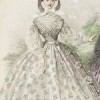
Rebecca N. Mitchell, “15 August 1862: The Rise and Fall of the Cage Crinoline”
First introduced to England by France’s Empress Eugénie in the late 1850s, the cage crinoline signaled a new era in fashion, reaching peak popularity (and peak circumference) in the early 1860s. While the garment has often been understood as a symbol of a repressive patriarchal order intent on confining women, contemporary reporting shows that it was regarded instead as a potentially threatening tool of emancipation. It replaced layers of heavy petticoats with a light and flexible alternative, offering women greater mobility and comfort, and the proportions of the skirts obviated the need for tight-laced corsets. What is more, donning crinoline allowed women to assert physical space in the public sphere, their voluminous skirts forcing men to the margins of the sidewalk or the omnibus—at least according to complaints. Perhaps the most pernicious quality of crinoline, though, was its potential to hide things from the male gaze: bad ankles or smuggled goods might be hidden by the cage, but the risk of concealed pregnancy loomed largest. Reports of death by crinoline fire were matched in their fevered pitch by warnings that crinoline sharply increased rates of infanticide. The range of Victorian responses that accrued around the fashion demonstrates that it was not simply a tool for unilateral oppression or reducible to the manifestation of empty, thoughtless vanity.
